Lia Purpura, Skate’s Egg Case (detail), featured in AGNI 102
heroic measures
He has advanced cancer. Surgery, radiation, chemotherapy, all had proved successful, for a while, but no longer. Now, his breathing is becoming labored. Will he be placed on a breathing machine? No, he says, or his wife and family say, no heroic measures.
The term dates to the eighteenth century. Then, “heroic measures” referred to the strenuous treatments of the day: blood-letting, most of all, but also emetics and purgatives. Blood-letting had been practiced for centuries, and still is, in a sense. But in the eighteenth century, physicians would draw off massive amounts of blood. While physicians of a former age might let four ounces or so, a trivial amount, Enlightenment physicians would bleed off several pints, enough to cause the patient to faint. If a little helped, it seemed logical that a lot would help more.
If these treatments made any sense at all, it was because they produced dramatic, visible results. The physician, or often a barber-surgeon whom he directed, would place a tourniquet and open a vein in the bend of the elbow. The basin would fill with blood. The patient’s pulse would quicken, the body temperature would cool, a ruddy complexion would pale. Given the appropriate medications—usually an herbal concoction, sometimes including animal products, occasionally minerals—the patient would vomit copiously, or sweat prodigiously, or evacuate buckets of watery diarrhea. These steps were admittedly drastic. But they did something, that no one could doubt. They were active interventions, not mere comforts; they violated the body, forcibly modified its constitution. This was not mere adjustment of imbalanced body humors; this was kinetic, forceful, yang. The world was increasingly understood as a complex mechanical contraption, likewise the body, and the physician manipulated it.
Viewed in strictly physiological terms, these steps seem unlikely to prove helpful. Viewed as a moment in the doctor-patient relation, one can see how the patient might improve. The patient saw and felt undeniable results, and he saw the physician labor on his behalf to produce them. Whether the patient survived or not, at least the physician did something. The physician commanded mighty forces, combating mortal enemies against all odds, braving catastrophe. The measures were heroic.
Yet the patient did not always improve and often worsened. The death of George Washington, a few days after repeated blood-letting, illustrated the problem and helped to mobilize counter-opinion. By the nineteenth century, heroic measures were criticized as too violent and too little effective. “Alternative medicine” entered the scene: homeopathy, hydrotherapy, galvanotherapy, animal magnetism. These practices were gentler. They criticized the treatment of the preceding generations as harmful, perhaps vainglorious. Their collective motto was “no heroic measures.”
The treatments changed, the phrase persisted. Today, we still say “no heroic measures.” The phrase is only used in the negative, when a person chooses to forego the more violent treatments of our own day: mechanical ventilation, cardiopulmonary resuscitation, electrical shocks to revive a failing heart. No one who chooses these interventions says, “Yes, I want heroic measures.” But a dying person who says No is asking for something gentler, softer, less dramatic, less violent. The last words of George Washington? —“’Tis well.”

Charles Bardes, M.D.
Charles Bardes is a physician who practices and teaches medicine in New York. His book-length prose poem, Diary of Our Fatal Illness (University of Chicago Press, Phoenix Poets, 2017), narrates the illness and death of an aged man. Other poems, essays, and ruminations have appeared in AGNI, Raritan, Ploughshares, The New England Journal of Medicine, and elsewhere. Pale Faces: The Masks of Anemia (Bellevue Literary Press, 2008) is an extended lyric essay that probes the mythological and cultural aspects of a common disease construct. In 2018 he received the Blackwell Prize in Writing, which “honors a writer who exhibits exceptional talent on the printed page, as well as meaningful social commitments on the public stage.” More info at charlesbardes.com. (updated 3/2020)
